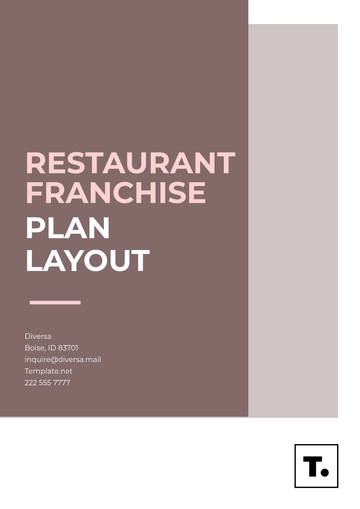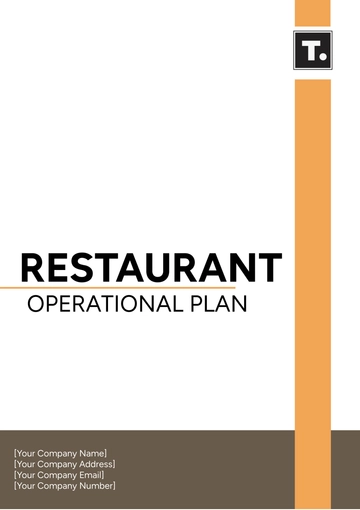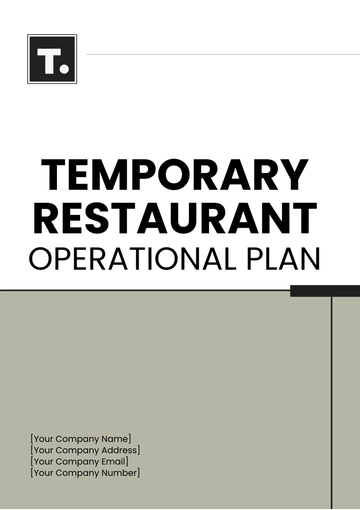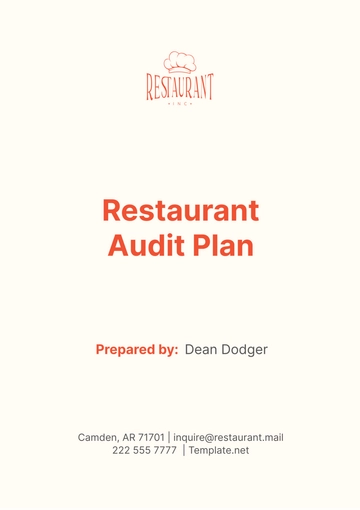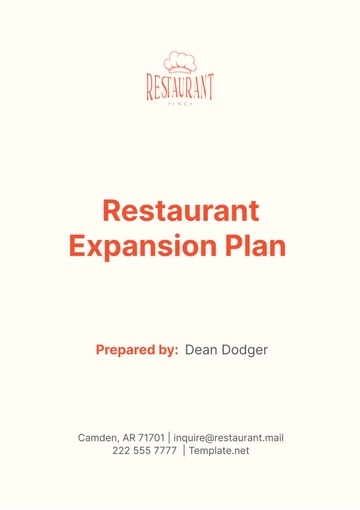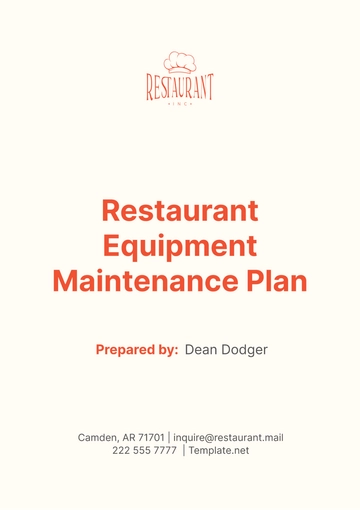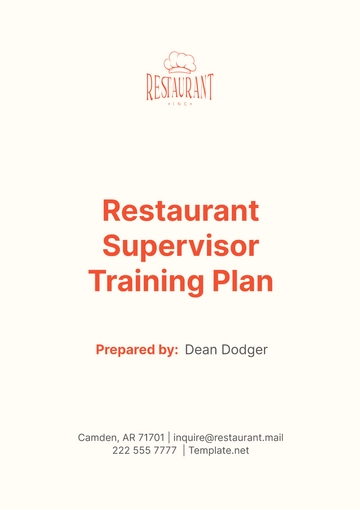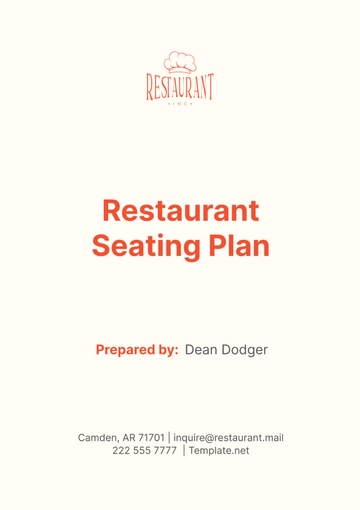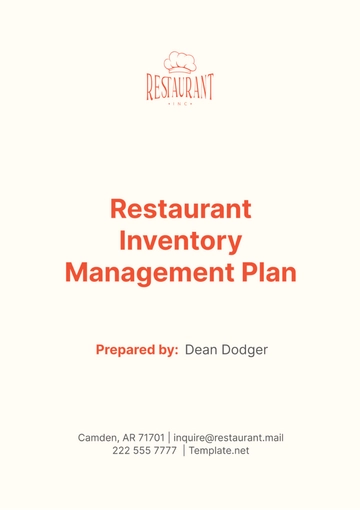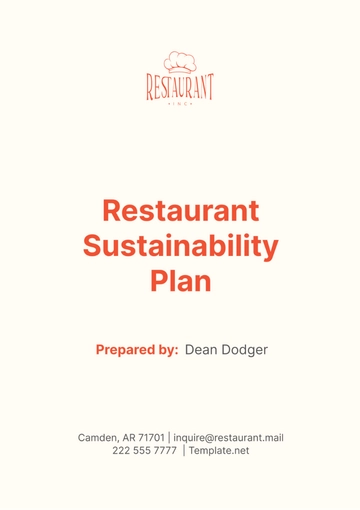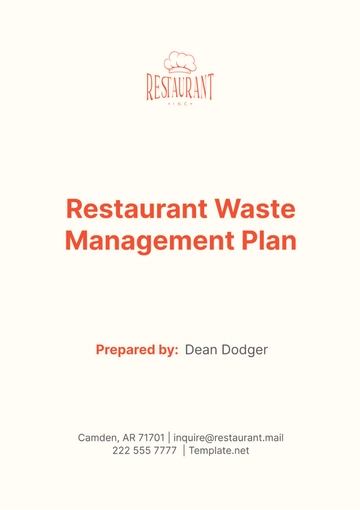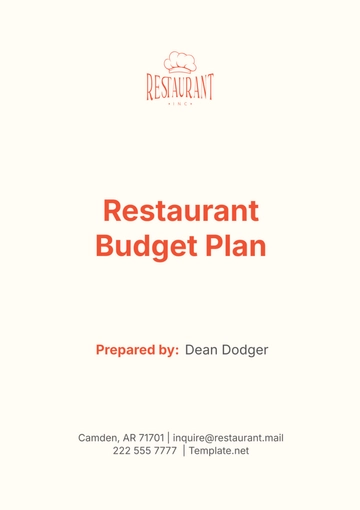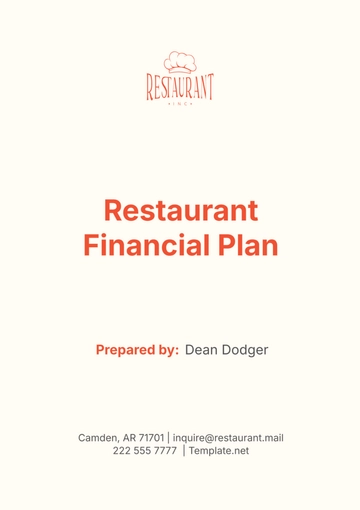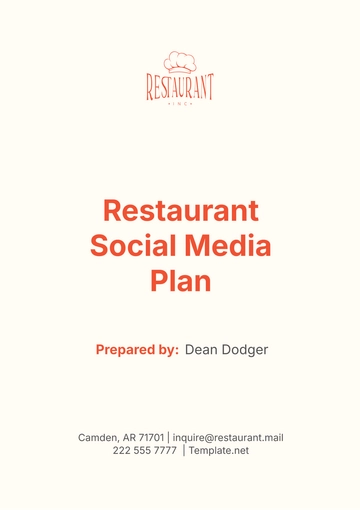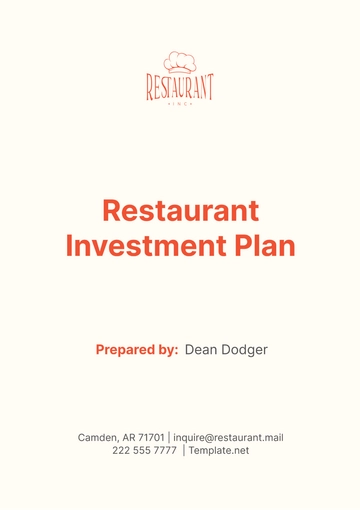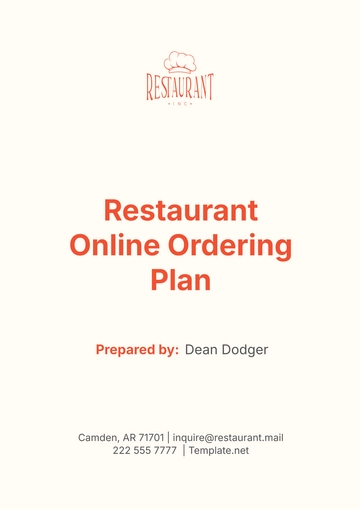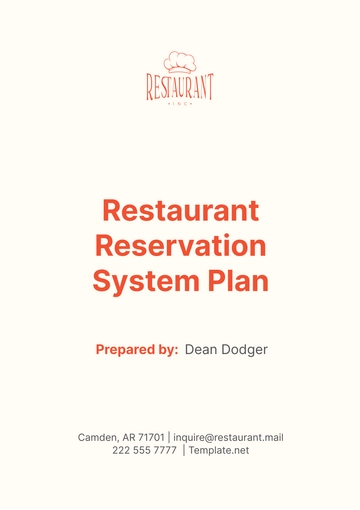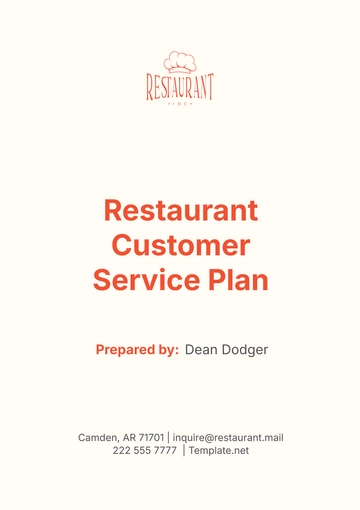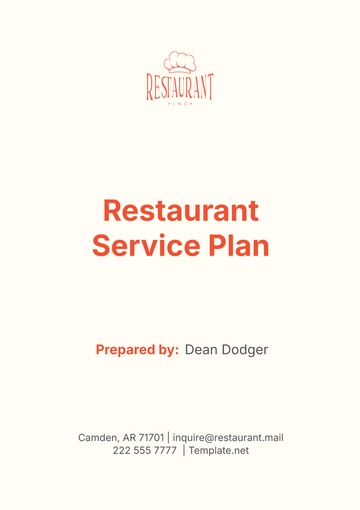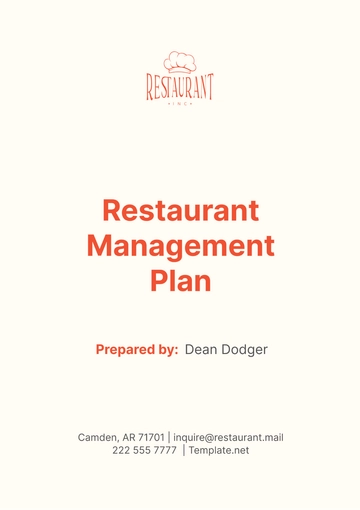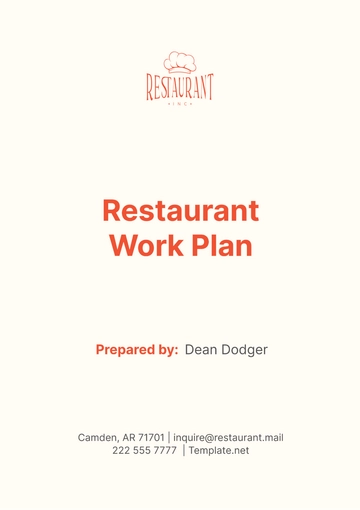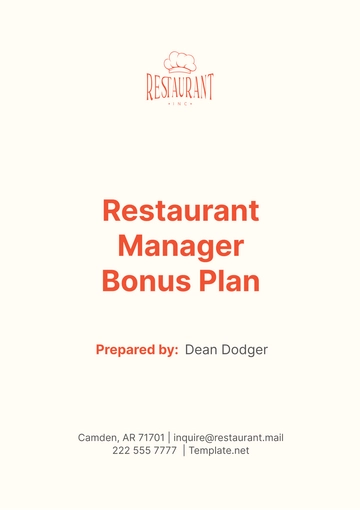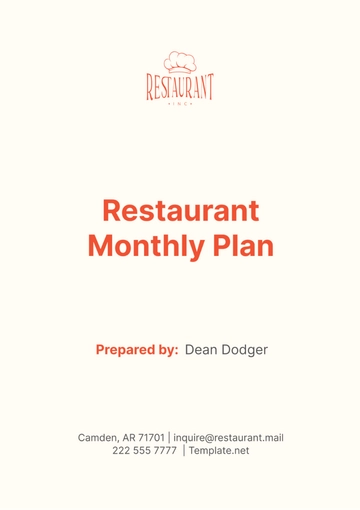Free Restaurant Equipment Maintenance Plan
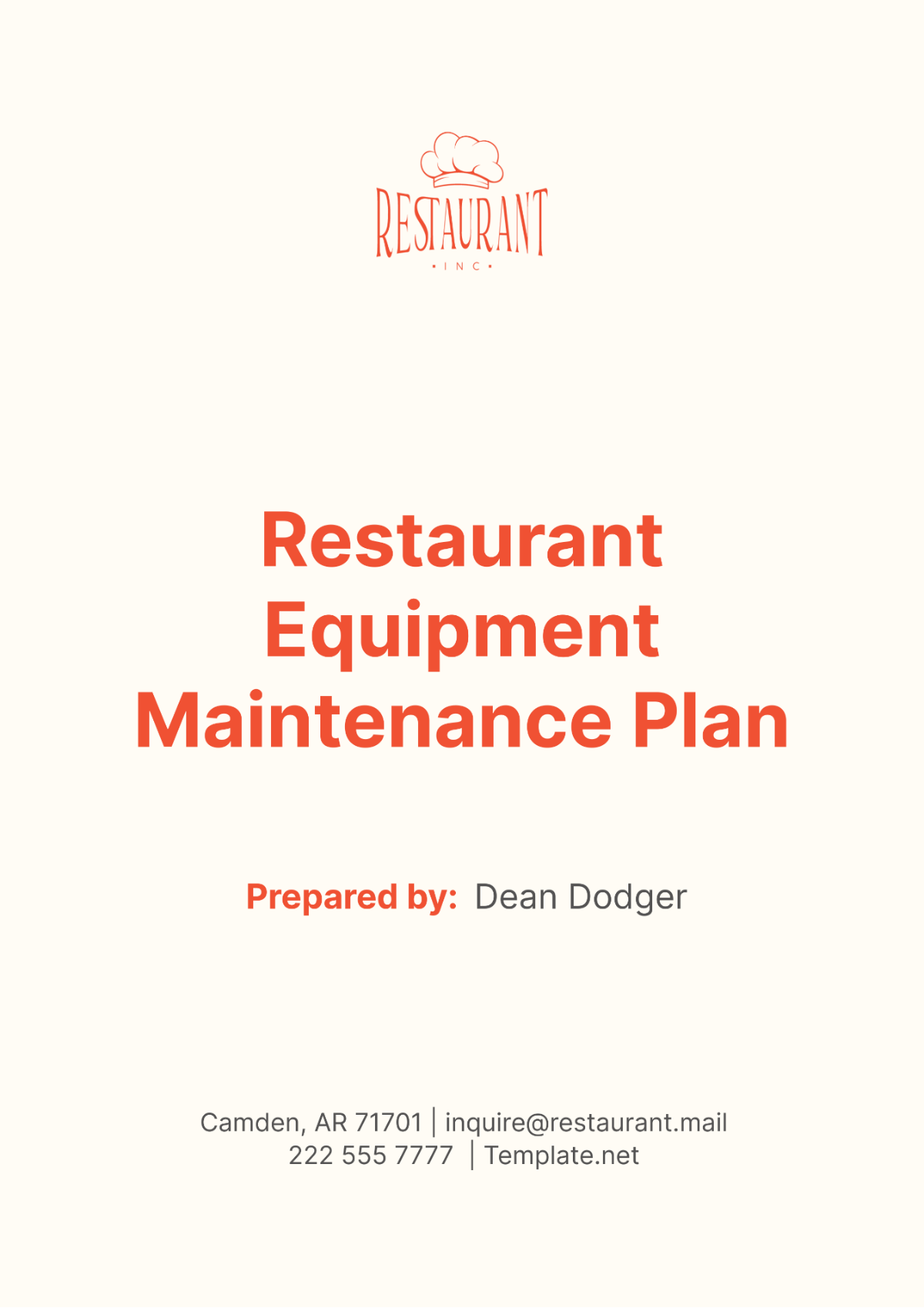
I. Introduction
A. Importance of Maintenance
Food Safety: Regular maintenance ensures that the equipment is clean and functioning properly, which is essential for food safety. Properly maintained equipment reduces the risk of foodborne illnesses and cross-contamination, ensuring that the food served to customers is safe and of high quality.
Operational Efficiency: Well-maintained equipment operates more efficiently, which can save time and reduce energy costs. Efficient equipment can perform tasks faster and consume less energy, leading to significant cost savings in the long run.
Longevity of Equipment: Regular maintenance can extend the lifespan of the equipment, preventing premature replacement costs. When equipment is regularly checked and maintained, it tends to last longer and perform better, reducing the need for frequent replacements.
B. Goals of the Maintenance Plan
Minimize Downtime: By regularly maintaining equipment, we can prevent unexpected breakdowns that could disrupt restaurant operations. Unplanned equipment downtime can lead to service delays, lost revenue, and dissatisfied customers.
Reduce Repair Costs: Regular maintenance can identify potential issues early before they become major, costly repairs. Small issues, if left unattended, can escalate into major problems that are expensive to repair.
Comply with Regulations: Restaurants are subject to various health and safety regulations, including those related to equipment maintenance. Regular maintenance helps ensure that we are complying with health and safety regulations.
II. Asset Inventory
The following table provides an inventory of the major equipment in the restaurant, including details such as the model number, location, purchase date, and warranty expiry:
Equipment Name | Model Number | Location | Purchase Date | Warranty Expiry |
|---|---|---|---|---|
Commercial Oven | COX1501 | Kitchen | 01/10/2060 | 01/10/2063 |
Refrigerator | REF5061 | Back Room | 15/07/2059 | 15/07/2062 |
Dishwasher | DW9012 | Kitchen | 23/03/2061 | 23/03/2064 |
Grill | GR38022 | Kitchen | 10/11/2058 | 10/11/2061 |
A. Commercial Oven
The commercial oven, model number COX1501, is located in the kitchen. It was purchased on 01/10/2060 and the warranty expires on 01/10/2063. The oven is a critical piece of equipment for the restaurant, used for a variety of cooking tasks.
B. Refrigerator
The refrigerator, model number REF5061, is located in the back room. It was purchased on 15/07/2059 and the warranty expires on 15/07/2062. The refrigerator is essential for storing perishable food items at safe temperatures.
C. Dishwasher
The dishwasher, model number DW9012, is located in the kitchen. It was purchased on 23/03/2061 and the warranty expires on 23/03/2064. The dishwasher plays a crucial role in maintaining cleanliness and hygiene in the restaurant.
D. Grill
The grill, model number GR38022, is located in the kitchen. It was purchased on 10/11/2058 and the warranty expires on 10/11/2061. The grill is used for a variety of cooking tasks, contributing to the diverse menu offerings of the restaurant.
Overall, maintaining an up-to-date asset inventory is crucial for effective equipment management. It helps in scheduling maintenance tasks, managing warranties, and planning for equipment replacement. It also provides a quick reference for service technicians, saving time during maintenance and repair tasks.
III. Maintenance Tasks
The following table outlines the key maintenance tasks for the restaurant equipment, along with their description, frequency, and the party responsible for each task:
Task | Description | Frequency | Responsible Party |
|---|---|---|---|
Oven Cleaning | Deep clean the oven interior and exterior to remove grease and residue | Weekly | Kitchen Staff |
Refrigerator Inspection | Check and clean condenser coils, verify temperature settings | Monthly | Maintenance Team |
Dishwasher Descaling | Run a descaling solution to remove mineral deposits | Quarterly | Maintenance Team |
Grill Calibration | Ensure proper heating levels and clean grill plates | Bi-Weekly | Kitchen Staff |
A. Oven Cleaning
The oven cleaning task involves a deep clean of the oven interior and exterior to remove grease and residue. This task is performed weekly by the kitchen staff. Regular cleaning of the oven is crucial for maintaining food safety and ensuring consistent cooking results.
B. Refrigerator Inspection
The refrigerator inspection task involves checking and cleaning the condenser coils and verifying the temperature settings. This task is performed monthly by the maintenance team. Regular inspection of the refrigerator is essential for maintaining optimal cooling performance and preventing food spoilage.
C. Dishwasher Descaling
The dishwasher descaling task involves running a descaling solution through the dishwasher to remove mineral deposits. This task is performed quarterly by the maintenance team. Regular descaling of the dishwasher is crucial for maintaining its cleaning performance and prolonging its lifespan.
D. Grill Calibration
The grill calibration task involves ensuring that the grill is heating at the proper levels and cleaning the grill plates. This task is performed bi-weekly by the kitchen staff. Regular calibration of the grill is essential for ensuring consistent cooking results and preventing food from burning.
In general, regular maintenance tasks are crucial for keeping the restaurant equipment in optimal condition. They help prevent unexpected breakdowns, ensure consistent performance, and extend the lifespan of the equipment. By following the maintenance tasks outlined in this plan, the restaurant can ensure a smooth and efficient operation.
IV. Budget Allocations
The following table provides an overview of the budget allocations for various maintenance-related items. These costs include cleaning agents, descaling solutions, replacement filters, and toolkits:
Item | Cost | Annual Total |
|---|---|---|
Cleaning Agents | $50/month | $600 |
Descaling Solutions | $30/quarter | $120 |
Replacement Filters | $100/year | $100 |
Toolkits | $200/year | $200 |
A. Cleaning Agents
Cleaning agents are essential for maintaining cleanliness and hygiene in the restaurant. They are used for cleaning various equipment and surfaces in the restaurant. The budget allocation for cleaning agents is $50 per month, amounting to an annual total of $600.
B. Descaling Solutions
Descaling solutions are used for removing mineral deposits from the dishwasher. Regular descaling helps maintain the dishwasher’s cleaning performance and prolong its lifespan. The budget allocation for descaling solutions is $30 per quarter, amounting to an annual total of $120.
C. Replacement Filters
Replacement filters are necessary for various equipment in the restaurant, such as the refrigerator and the ventilation system. Regular replacement of filters ensures optimal performance of the equipment and maintains a healthy environment in the restaurant. The budget allocation for replacement filters is $100 per year.
D. Toolkits
Toolkits are essential for performing various maintenance tasks. They include tools for cleaning, repairing, and inspecting the restaurant equipment. The budget allocation for toolkits is $200 per year.
In a nutshell, budget allocations for maintenance-related items are crucial for effective equipment management. They ensure that the necessary resources are available for performing regular maintenance tasks. By planning for these costs in the budget, the restaurant can prevent unexpected expenses and manage its finances more effectively.
V. Emergency Procedures
In the event of an equipment failure or other emergencies, it’s important to have clear procedures in place. These procedures ensure a quick and effective response to minimize downtime and ensure safety.
A. Contact Information
In case of an emergency, the following individuals or services should be contacted:
Name | Role | Contact Information |
|---|---|---|
Harry Mitchell | Facility Manager | 333 444 8888 |
Gary Gibson | Maintenance Supervisor | |
QuickFix | Emergency Repair Service |
The individuals and services listed in the table above play a critical role in managing emergencies. They are equipped with the knowledge and skills necessary to address various situations, from equipment failure to safety hazards. It is important to keep this contact information updated and readily accessible to all staff members.
Moreover, this serves as a reminder of the importance of clear communication lines in crisis management. By knowing who to contact and how, staff can react more confidently and effectively in an emergency, reducing panic and confusion. This contributes to a safer and more secure working environment for everyone.
B. Response Guidelines
In the event of an equipment failure or other emergencies, it is crucial to have a clear set of response guidelines. Here are the steps to be taken:
Immediate Shutdown: If a piece of equipment is malfunctioning, the first step is to shut it down immediately. This action prevents further damage and potential safety hazards.
Hazard Assessment: Once the equipment is safely shut down, the next step is to assess the situation for any immediate hazards. This could include electrical issues, potential fire risks, or other safety concerns.
Notification: After assessing the situation, it’s important to notify the Maintenance Supervisor and Facility Manager. They need to be informed about the situation as they have the authority and expertise to make critical decisions regarding the next steps.
Professional Assistance: If the situation cannot be handled internally, the next step is to contact the Emergency Repair Service. They have the skills and tools necessary to address and resolve the issue quickly and effectively.
Documentation: Lastly, it’s important to document the incident thoroughly. This includes details about the equipment, the nature of the failure or emergency, the steps taken, and the outcome.
VI. Additional Reminders
A. Maintenance Logs
Regular Updates: Regularly updating maintenance logs is crucial. This practice helps track equipment performance and identify patterns.
Preventive Maintenance: These logs aid in planning preventive maintenance schedules, helping to prevent unexpected equipment failures.
B. Safety Gear
Safety First: Always prioritize safety. Wearing appropriate safety gear during maintenance tasks is a must.
Prevent Accidents: This practice helps protect against potential hazards, preventing accidents and injuries.
C. Documentation Accessibility
Easy Access: Ensure all maintenance documentation is easily accessible. This includes manuals, maintenance logs, and emergency procedures.
Empower Staff: Easy access to information empowers staff, enabling them to operate and maintain equipment properly.
Regular Updates: Keep these documents updated. As equipment and procedures evolve, so should our documentation.
D. Staff Training
Regular Sessions: Regular training sessions are essential. These sessions should cover equipment usage, basic troubleshooting, and emergency procedures.
Continuous Learning: Training should be a continuous process. Regular refresher courses and updates on new equipment or procedures keep our staff’s skills sharp.
VII. Conclusion
Implementing a comprehensive maintenance plan is not just a necessity, but a strategic move for the smooth operation and safety of [Your Company Name]'s facilities. This plan, meticulously designed and regularly updated, ensures that all equipment is maintained to the highest standards. It serves as our proactive approach to preventing costly downtimes, enhancing operational efficiency, and maintaining compliance with health and safety guidelines.
The effectiveness of this plan is a testament to [Your Company Name]'s commitment to quality and excellence. It reflects our dedication to providing the best possible service to our customers while ensuring a safe and efficient working environment for our staff. By adhering to this plan, we are not only maintaining our equipment but also investing in the longevity and success of our restaurant.
- 100% Customizable, free editor
- Access 1 Million+ Templates, photo’s & graphics
- Download or share as a template
- Click and replace photos, graphics, text, backgrounds
- Resize, crop, AI write & more
- Access advanced editor
Maintain equipment efficiently with a tailored plan with this Restaurant Equipment Maintenance Plan Template available only here on Template.net! This editable solution ensures you generate your plan effortlessly. Its customizable sections ensure all equipment is covered, and the AI Editor Tool helps create detailed and professional maintenance plans right away!
You may also like
- Finance Plan
- Construction Plan
- Sales Plan
- Development Plan
- Career Plan
- Budget Plan
- HR Plan
- Education Plan
- Transition Plan
- Work Plan
- Training Plan
- Communication Plan
- Operation Plan
- Health And Safety Plan
- Strategy Plan
- Professional Development Plan
- Advertising Plan
- Risk Management Plan
- Restaurant Plan
- School Plan
- Nursing Home Patient Care Plan
- Nursing Care Plan
- Plan Event
- Startup Plan
- Social Media Plan
- Staffing Plan
- Annual Plan
- Content Plan
- Payment Plan
- Implementation Plan
- Hotel Plan
- Workout Plan
- Accounting Plan
- Campaign Plan
- Essay Plan
- 30 60 90 Day Plan
- Research Plan
- Recruitment Plan
- 90 Day Plan
- Quarterly Plan
- Emergency Plan
- 5 Year Plan
- Gym Plan
- Personal Plan
- IT and Software Plan
- Treatment Plan
- Real Estate Plan
- Law Firm Plan
- Healthcare Plan
- Improvement Plan
- Media Plan
- 5 Year Business Plan
- Learning Plan
- Marketing Campaign Plan
- Travel Agency Plan
- Cleaning Services Plan
- Interior Design Plan
- Performance Plan
- PR Plan
- Birth Plan
- Life Plan
- SEO Plan
- Disaster Recovery Plan
- Continuity Plan
- Launch Plan
- Legal Plan
- Behavior Plan
- Performance Improvement Plan
- Salon Plan
- Security Plan
- Security Management Plan
- Employee Development Plan
- Quality Plan
- Service Improvement Plan
- Growth Plan
- Incident Response Plan
- Basketball Plan
- Emergency Action Plan
- Product Launch Plan
- Spa Plan
- Employee Training Plan
- Data Analysis Plan
- Employee Action Plan
- Territory Plan
- Audit Plan
- Classroom Plan
- Activity Plan
- Parenting Plan
- Care Plan
- Project Execution Plan
- Exercise Plan
- Internship Plan
- Software Development Plan
- Continuous Improvement Plan
- Leave Plan
- 90 Day Sales Plan
- Advertising Agency Plan
- Employee Transition Plan
- Smart Action Plan
- Workplace Safety Plan
- Behavior Change Plan
- Contingency Plan
- Continuity of Operations Plan
- Health Plan
- Quality Control Plan
- Self Plan
- Sports Development Plan
- Change Management Plan
- Ecommerce Plan
- Personal Financial Plan
- Process Improvement Plan
- 30-60-90 Day Sales Plan
- Crisis Management Plan
- Engagement Plan
- Execution Plan
- Pandemic Plan
- Quality Assurance Plan
- Service Continuity Plan
- Agile Project Plan
- Fundraising Plan
- Job Transition Plan
- Asset Maintenance Plan
- Maintenance Plan
- Software Test Plan
- Staff Training and Development Plan
- 3 Year Plan
- Brand Activation Plan
- Release Plan
- Resource Plan
- Risk Mitigation Plan
- Teacher Plan
- 30 60 90 Day Plan for New Manager
- Food Safety Plan
- Food Truck Plan
- Hiring Plan
- Quality Management Plan
- Wellness Plan
- Behavior Intervention Plan
- Bonus Plan
- Investment Plan
- Maternity Leave Plan
- Pandemic Response Plan
- Succession Planning
- Coaching Plan
- Configuration Management Plan
- Remote Work Plan
- Self Care Plan
- Teaching Plan
- 100-Day Plan
- HACCP Plan
- Student Plan
- Sustainability Plan
- 30 60 90 Day Plan for Interview
- Access Plan
- Site Specific Safety Plan
